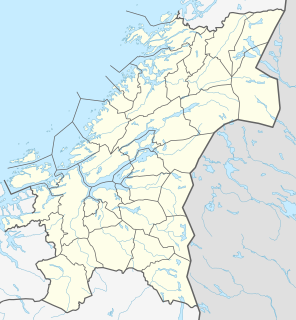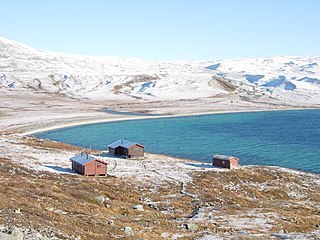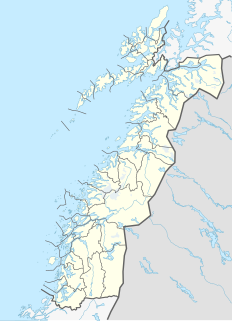
Borders of Norway may refer to:

Borders of Norway may refer to:

The krone[ˈkrûːnə], plural kroner, is the currency of Norway and its dependent territories. It is subdivided into 100 øre, which have existed only electronically since 2012. The name translates into English as crown.

Kirkenes is a town in Sør-Varanger Municipality in Troms og Finnmark county, in the far northeastern part of Norway. The town lies on a peninsula along the Bøkfjorden, an arm of the large Varangerfjorden. The main church for Kirkenes is Kirkenes Church, located in the Haganes area of the town. Kirkenes is located just a few kilometres from the Norway-Russia border.

Norway is divided into 11 administrative regions, called counties until 1918, they were known as amter. The counties form the first-level administrative divisions of Norway and are further subdivided into 356 municipalities. The island territories of Svalbard and Jan Mayen are outside the county division and ruled directly at the national level. The capital Oslo is considered both a county and a municipality.

The extreme points of Norway include the coordinates that are farther north, south, east or west than any other location in Norway; and the highest and the lowest altitudes in the country. The northernmost point is Rossøya on Svalbard, the southernmost is Pysen in Mandal, the easternmost is Kræmerpynten on Svalbard, and the westernmost is Hoybergodden on Jan Mayen. The highest peak is Galdhøpiggen, standing at 2,469 m (8,100 ft) above mean sea level, while the lowest elevation is sea level at the coast.

Femunden is Norway's third largest lake and the second largest natural lake in Norway. It is located in Innlandet and Trøndelag counties in Norway, just 13 kilometres (8.1 mi) west of the border with Sweden. The lake lies primarily in the municipality of Engerdal and also smaller parts are located in the municipalities of Os (Innlandet) and Røros (Trøndelag). Femundsmarka National Park borders the northeastern part of the lake.

The Nordic Passport Union allows citizens of the Nordic countries – Iceland, Denmark, Norway, Sweden, and Finland – to travel and reside in another Nordic country without any travel documentation or a residence permit. Since 25 March 2001, all five states have also been within the Schengen Area. The Faroe Islands are part of the Nordic Passport Union but not the Schengen Area, while Greenland and Svalbard are outside both. However, Greenland has an open border with all Nordic countries, and allows Nordic citizens to enter, settle and work without requiring a passport or permits. Svalbard allows Nordic citizens to settle and work without permits, as a result of the Svalbard Treaty, however valid travel documentation is required to enter Svalbard. Norwegian citizens may use other documents such as a Norwegian driving licence until 31 December 2021. Furthermore, as citizens of a Nordic country, those from Svalbard and Greenland are permitted to reside in any other Nordic country.

The European route E45 goes between Norway and Italy, through Finland, Sweden, Denmark, Germany and Austria. With a length of about 5,190 kilometres (3,225 mi), it is the longest north–south European route.

Rogen or Rovje is a lake on the border of Sweden and Norway. The lake is mostly located in Härjedalen Municipality in Jämtland county in Sweden with a small portion crossing the Norwegian border in the municipalities of Røros and Engerdal. The 35.12-square-kilometre (13.56 sq mi) lake is the source of Sweden's longest river, Klarälven.

Balvatnet (Norwegian) or Bállávrre (Lule Sami) is a lake that lies in the municipality of Saltdal in Nordland county, Norway. The 41.46-square-kilometre (16.01 sq mi) lake is located on the border of Junkerdal National Park, about 2 kilometres (1.2 mi) west of the border with Sweden. The lake is regulated for hydroelectric power at the Daja Hydroelectric Power Station 16 kilometres (9.9 mi) to the north in Sulitjelma.

Gresvatnet (Norwegian) or Gräsvattnet (Swedish) or Graesiejaevrie (Southern Sami) is a lake on the border between Norway and Sweden. Most of the lake lies in Hemnes Municipality in Nordland county (Norway) and then a small portion crosses the border into Storuman Municipality in Västerbotten County (Sweden). The lake lies about 25 kilometres (16 mi) east of the village of Korgen, and just a few kilometres northeast of the mountain Oksskolten and the Okstindbreen glacier. The lake is one of the upper reservoirs for the Bjerka Hydroelectric Power Station.

Nordre Bjøllåvatnet (Norwegian) or Bajep Ruovdajávrre (Lule Sami) is a lake that lies in the municipality of Saltdal in Nordland county, Norway. The 9.93-square-kilometre (3.83 sq mi) lake is located inside Saltfjellet–Svartisen National Park, about 1 kilometre (0.62 mi) east of the border with the municipality of Beiarn and north of the border with the municipality of Rana. The lake flows out through the river Bjøllåga and ultimately into the river Ranelva.

Ranseren (Norwegian), also known as Bije-Ransarn (Swedish) or Bijjie Raentsere (Southern Sami), is a lake on the border between Norway and Sweden. The Norwegian side lies in Hattfjelldal Municipality in Nordland county. The Swedish side of the lake is called Bije-Ransaren, which means "the upper Ransaren" and this part lies in Vilhelmina Municipality in Västerbotten County.

Saglivatnet is a lake on the border of Trøndelag and Nordland counties in Norway. The 2.16-square-kilometre (0.83 sq mi) lake lies on the border of the municipalities of Nærøysund and Bindal. The water flows out to the north into the river Saglielva which flows into the Sørfjorden, an arm off the main Bindalsfjorden.

The Norwegian Police Service is the Norwegian national civilian police agency. It consists of a central National Police Directorate, seven specialty agencies and twelve police districts. The government agency is subordinate to the Ministry of Justice and Public Security and has 16,000 employees, of which 8,000 are police officers. In addition to police powers, the service is responsible for border control, certain civil duties, coordinating search and rescue operations, counter-terrorism, highway patrolling, writ of execution, criminal investigation and prosecution.

Nedre Roasten is a lake in Femundsmarka National Park on the border of Innlandet and Trøndelag counties in Norway. The 2.29-square-kilometre (0.88 sq mi) lake sits on the border of the municipalities of Engerdal in Innlandet county and Røros in Trøndelag county. Nedre Roasten is about 50 kilometres (31 mi) southeast of the town of Røros and just under 9 kilometres (5.6 mi) from the border with Sweden. The lake lies about 5 kilometres (3.1 mi) east of the lake Femunden and about 8 kilometres (5.0 mi) west of the lake Rogen which sits along the Swedish border.

Norway–Russia relations refers to the bilateral foreign relations between the two countries, Norway and Russia. The establishment of diplomatic relationships between the two countries happened on October 30, 1905, four days after the establishment of Norway's independence. Russia has an embassy in Oslo and consulates in Barentsburg and Kirkenes, and Norway has an embassy in Moscow, and consulates in Murmansk and Saint Petersburg.

The border between Norway and Russia consists of a 195.7-kilometer (121.6 mi) land border between Sør-Varanger, Norway, and Pechengsky District, Russia, and a 23.2-kilometer (14.4 mi) marine border in the Varangerfjord. It further consists of a border between the two countries' exclusive economic zones (EEZ) in the Barents Sea and the Arctic Ocean. Between 1944 and 1991 the border was between Norway and the Soviet Union. There is a single border crossing, on E105, located at Storskog in Norway and Borisoglebsky in Russia. The Norwegian side is patrolled by the Garrison of Sør-Varanger and is under the jurisdiction of the Norwegian Border Commissioner, while the Russian side is patrolled by the Border Guard Service of Russia. Two-thirds of the border follows two rivers, the Pasvikelva and Jakobselva.

The Dano-Swedish War of 1808–1809 was a war between Denmark–Norway and Sweden due to Denmark–Norway's alliance with France and Sweden's alliance with the United Kingdom during the Napoleonic Wars. Neither Sweden nor Denmark-Norway had wanted war to begin with but once pushed into it through their respective alliances, Sweden made a bid to acquire Norway by way of invasion while Denmark-Norway made ill-fated attempts to reconquer territories lost to Sweden in the 17th century. Peace was concluded on grounds of status quo ante bellum on 10 December 1809.

The term Norwegian Realm and Old Kingdom of Norway refer to the Kingdom of Norway's peak of power at the 13th century after a long period of civil war before 1240. The kingdom was a loosely unified nation including the territory of modern-day Norway, modern-day Swedish territory of Jämtland, Herjedalen, Ranrike (Bohuslän) and Idre and Särna, as well as Norway's overseas possessions which had been settled by Norwegian seafarers for centuries before being annexed or incorporated into the kingdom as 'tax territories'. To the North, Norway also bordered extensive tax territories on the mainland. Norway, whose expansionalism starts from the very foundation of the Kingdom in 872, reached the peak of its power in the years between 1240 and 1319.
The Norwegian Border Commissioner of the Norwegian-Russian border is a Norwegian government agency subordinate the Ministry of Justice and Public Security that is headed by the National Police Directorate. The agency's main task is to ensure that the Border Agreement of 1949 between Norway and the then Soviet Union, with subsequent regulations, laws and codes of conduct and traffic in the border area are complied with.